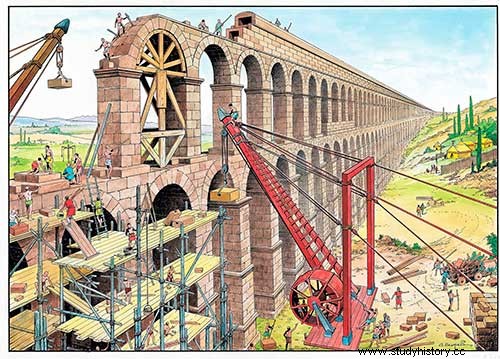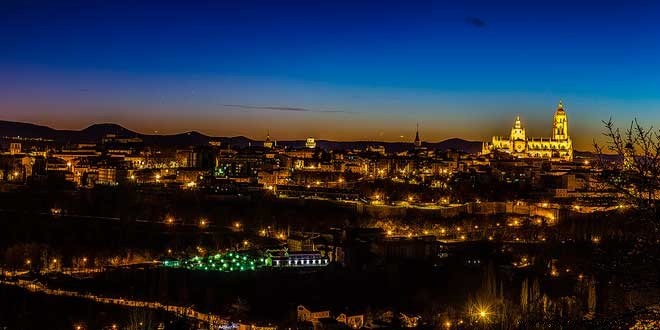On an ancient pre-Roman site, perhaps of Celtic origin, the first urban infrastructure of the Roman city of Segovia was located, following the usual form of a military settlement, on the road that would later join Mérida and Zaragoza, and in front of the place that currently occupies the Alcázar building.
Located on the foothills of Guadarrama, on the left bank of the river Eresma, its strategic importance explains the antiquity of its population, which dates back to the time of the Iberians, who used it as a military outpost with the mission of controlling access to the valley of the Douro.
From the times of Roman occupation, the only remains, and one of the most important legacies of the Roman Empire in the Peninsula, is the aqueduct of Segovia . This very important architectural work was built by the Romans, according to some historians (including Menéndez Pidal), in the time of Augustus; others think that it was built in the second half of the 1st century, at the time of Claudius; Finally, there are those who think that its construction can be included in the works carried out in Hispania by order of Emperor Trajan. Latest studies place the date of construction of the Segovia Aqueduct in the second century of our era, from the years 112 and 116, it occurred either at the end of the government of Trajan, or in the government of Hadrian . Be that as it may, the construction of the aqueduct implied the creation of an urban cyclopean work that is integrated into its natural setting, rhythmically adapting to the terrain, and that confers an indescribable grandeur and monumentality to the urban landscape. Its function was to carry water from the Acebeda River to the upper part of the city, crossing the Vado de los Clamores and culminating in the Plaza del Azoguejo, twenty-nine meters high, collecting water from a dam some thirteen kilometers away.

Measurements and architecture of the Segovia aqueduct
The Segovia aqueduct has a length of about 728 meters and a maximum height of 28.5 meters, to which must be added about six meters of foundations in the main section . It consists of a double arcade, the lower one formed by 119 semicircular arches of different spans, depending on the section and the adaptations to the profile of the land, and the upper one, with 44 arches that constitute the central nucleus of the aqueduct. In its longitudinal structure, four sections can be distinguished from the sand trap or water decanter:the first alignment is made up of six semicircular arches of rough construction and a growing height that reaches up to two and a half meters at the top. On a cornice that rests on the keystones of the arches appears the masonry attic, which contains the water channel, which is maintained throughout the work with a U-shaped section. The second alignment is made up of twenty-five arcades that , in large part, was rebuilt in the time of the Catholic Monarchs; the third has a total of 44 arcades, of which the 1 or first ones have been renovated. The last section corresponds to the main area of the aqueduct and is made up of 44 arcades superimposed on two floors, except for the two at the ends. On the upper floor, the arches have a span of about five meters, somewhat larger than the lower arches, and the pillars are lower in height and thickness. This floor is finished off with the attic where the canal runs, adapting the lower floor to the unevenness of the land. Here, the arches have a span that varies around five meters, and the pillars decrease in thickness in stages, from bottom to top:at the crown there is a medium-sized section (1.80 x 2.50 m), while at the base these increase (2.40 x 3 m).
For its construction, berroqueña stone, thick-grain granite and purple color were used, the ashlars being carved on purpose for the place they occupy, roughly carved, joined without any type of mortar and placed on bone.

The aqueduct of Segovia as a monument
Two legends are told about the Aqueduct of Segovia. The first says that it was the Egyptian Hercules who raised it with his bare hands. The second tells that the devil was its builder, in order to buy the soul of a young woman who crossed the valley daily . But the virgin intervened, finally taking advantage of the play. Irritated by defeat, the devil would confuse all those who tried to count the number of his bows. In memory of these two legends, we can find two sculptural images along the aqueduct. From the monumental point of view, the Romans created a particular aesthetic from the combination of the wall with the hole. This association creates an image that was the basis of the one used in bridges and other constructions of the Empire in which the arch and the lintel, the dynamic and the static, are balanced, the idea of solid and vain, of light and dark that will be so fruitful for future cultures.
The magnificent monument has been kept in a good state of conservation, without major transformations, due in a certain way to the overwhelming and mysterious grandeur of the structure, which commands respect, and to the fact that even today, it continues to perform its original function.
The first major reconstruction work must have been carried out in the times of the Catholic Monarchs:the prior of the Jerónimos del Parral monastery, Don Pedro de Mesa, was commissioned to manage the reconstruction works between 1484 and 1489, when 36 arches respecting the original work as much as possible, although some arches have a slight tendency to a pointed shape and a less coarse carving than that of the Roman ashlars. In the 16th century, the statues of the patron saint of Segovia, the Virgen de la Fuencisla, and San Sebastián were replaced in the niches of the central pillar.
In 1985 the aqueduct was declared a World Heritage Site, because it is one of the greatest hydraulic engineering works of the Roman Empire . But currently the state of deterioration of the stone due to atmospheric contamination has been so alarming that the State, with the help of other national and international organizations, has had to protect it through a meticulous restoration process.

